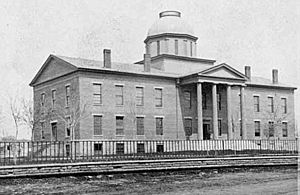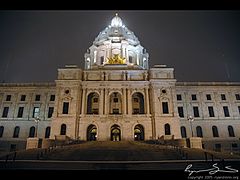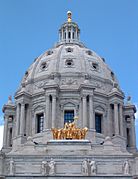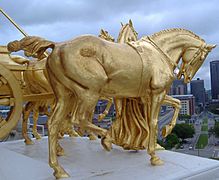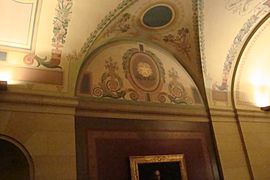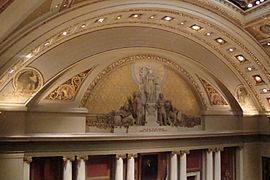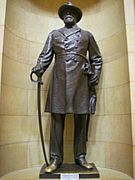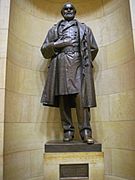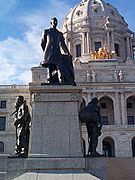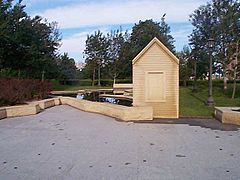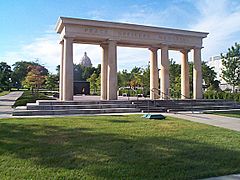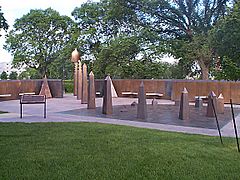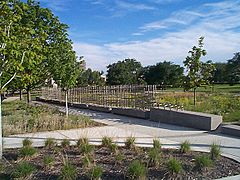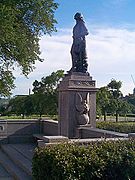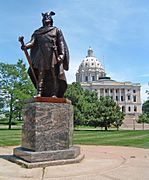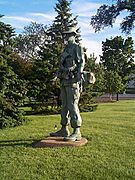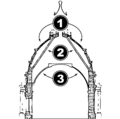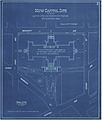Minnesota State Capitol facts for kids
Quick facts for kids |
|
|
Minnesota State capitol building
|
|
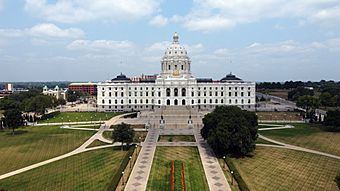
The Minnesota State Capitol from the south
|
|
| Location | 75 Rev. Martin Luther King Jr Boulevard, Saint Paul, Minnesota |
|---|---|
| Built | 1896–1905 |
| Architect | Cass Gilbert |
| Architectural style | Italian Renaissance, Beaux-Arts |
| NRHP reference No. | 72000681 |
| Added to NRHP | February 23, 1972 |
The Minnesota State Capitol is the seat of government for the U.S. state of Minnesota, in its capital city of Saint Paul. It houses the Minnesota Senate, Minnesota House of Representatives, the office of the Attorney General and the office of the Governor. The building also includes a chamber for the Minnesota Supreme Court, although court activities usually take place in the neighboring Minnesota Judicial Center.
There have been three State Capitol buildings. The present building was designed by architect Cass Gilbert and completed in 1905. Its Beaux-Arts/American Renaissance design was influenced by the 1893 World's Columbian Exposition in Chicago, and by McKim, Mead & White's Rhode Island State House. From 2013 to 2017 the building underwent an extensive restoration. This included replacing existing infrastructure; adding new mechanical systems; replacing or repairing tens of thousands of pieces of marble on the exterior; cleaning historic paintings, murals, and sculptures; and adding safety and accessibility features.
The building is set in a landscaped campus with the Capitol Mall on its south front, Leif Erikson Park on its west, and Judicial Plaza to its east. Various monuments and memorials are located in these green spaces.
Contents
Architecture
The building was built by Butler-Ryan Construction and designed by Cass Gilbert and modeled after Saint Peter's Basilica in Rome - the unsupported marble dome is the second largest in the world, after Saint Peter's. However, like all capitols with domes in the US it is also inspired by the idea of domed capitols originating with the United States Capitol dome. Work began on the capitol in 1896, and construction was completed in 1905. It is the third building to serve this purpose: the first capitol was destroyed by fire in 1881, and the second was completed in 1883, but was considered to be too small almost immediately.
Above the southern entrance to the building is a gilded quadriga called The Progress of the State which was sculpted by Daniel Chester French and Edward Clark Potter. It was completed and raised to the roof of the capitol in 1906. The four horses represent the power of nature: earth, wind, fire and water. The women leading the horses symbolize civilization, and the man on the chariot represents prosperity. In 1994 and 1995, the statues underwent a restoration procedure which included replacing the gold leaf on the figures. A sphere perched above the capitol dome also has similar treatment.
Any classical dome built since Michelangelo's must expect to be compared to it, and Gilbert's dome is a frank homage, with interesting differences. His drawings show that he originally planned a wider drum and, correspondingly, a more massive dome. The smaller dome as built could be criticized by some as too small. It is smaller than St. Peter's and has a simplified design: single columns round the upper lantern instead of double ones, for instance. The ribs on the capitol dome are less pronounced than those on St. Peter's, but they are still visually apparent. Gilbert knew that St. Peter's dome was on the edge of being unstable: it had cracked and had to be reinforced. His engineer for this project, Gunvald Aus, bound the brick dome in reinforcing steel bands, and Gilbert crowned the paired columns round the drum (which act as buttresses to counter the dome's weight) with additional stone. Other than St. Peter's, additional buildings with marble domes include the Taj Mahal in India, and the Rhode Island State House in the city of Providence.
The central block under the dome needed three entrances, and Gilbert avoided creating visual references to a triumphal arch, which would have been inappropriate in its position. Equally, he managed to avoid any reference to a palace block that would have been offensive to Minnesotans. However, Gilbert drew ire for choosing stone from Georgia rather than native Minnesota stone. A compromise was eventually made where the base of the building and interior spaces used varieties of native stone, including Kasota stone, and the rare Minnesota Pipestone used by Native Americans for their peace pipes. Upon completion, the exterior and interior of the building drew praise, leading to requests for Gilbert to design capitol buildings for other states such as West Virginia and Arkansas and other notable structures.
The capitol cost US$4.5 million at the beginning of the 20th century. It opened its doors to the public for the first time on January 2, 1905. A hundred years later, the building's estimated value was $400 million.
Most days of the week the building is open for individual visits, and organized tours are frequently given, including a stair climb onto the roof below the quadriga. Upon entering the building by the south door, one is below the central dome. A large star, symbolizing Minnesota's motto, "The Star of the North", is directly beneath the apex. Various portraits of state governors, and flags captured by Minnesota's regiments during the American Civil War, are on display. Paintings showing some of the related battles can be seen in the governor's outer office. Much of the building is open to the public, although one interesting sight is only rarely accessible. This is the cloak room behind the House of Representatives chamber. The walls are painted to simulate a north woods forest, but in one corner is a tiny four leaf clover. This was added by an Irish artist to remember his home island.
The structure was added to the National Register of Historic Places in 1972.
2015-17 Renovation
Beginning in 2015, the capitol began a major, $272.7 million renovation project. The project was intended to increase public meeting space, add a classroom for the Minnesota Historical Society to provide information about the building, and improve accessibility for people with disabilities. During renovation, more than 30,000 pieces or marble were restored or replaced, and electrical and plumbing systems were modernized.
The renovation forced the House and Senate to hold a special session in the nearby State Office Building in 2015. During the regular 2016 session, the Senate met in the newly-completed Senate Office Building, with the capitol open for only limited access to the House chamber during the session.
The bulk of construction on the renovation was completed by the start of the 2017 legislative session. The project is due for completion by August of 2017.
Gallery
-
Above the House of Representatives chamber is Lady Minnesota with two pioneers to her left. To her right are a Native American chief and Sacagawea in honor of the people who lived in Minnesota before the pioneers. On the book that she holds in her left hand are both the dates of Minnesota's founding as a territory and state.
Memorials in the rotunda
-
William J. Colvill Memorial
-
James Shields Memorial
-
John B. Sanborn Memorial
Monuments on the grounds
-
Roy Wilkins Memorial
Images for kids
See also
 In Spanish: Capitolio del Estado de Minnesota para niños
In Spanish: Capitolio del Estado de Minnesota para niños




